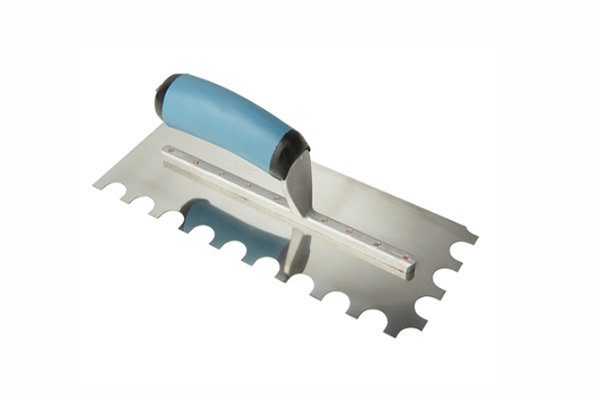In tile installation, choosing the correct trowel size is crucial for achieving a strong, even bond between the tile and the substrate. The 1/2 inch trowel—usually referring to a 1/2 inch square notch trowel—is one of the larger notched trowels used in the trade. Its deeper notches hold and spread more adhesive (thinset mortar) compared to smaller trowels. But when exactly should you use it? Let’s explore the scenarios where a 1/2 inch trowel is the right choice.
Understanding Trowel Size and Notch Shape
Trowel sizes are generally described by the notch size (width and depth) and the notch shape (square, V-shaped, or U-shaped). A 1/2 inch square notch trowel means:
-
Each notch is 1/2 inch wide.
-
Each notch is 1/2 inch deep.
-
The notches are square, creating thick, even ridges of mortar.
The bigger the notch, the more mortar is applied to the surface, which is essential for bonding large or uneven tiles.

When to Use a 1/2 Inch Trowel
1. Large Format Tiles
The most common reason to use a 1/2 inch trowel is when installing large format tiles—usually defined as any tile with at least one side longer than 15 inches. These tiles require more mortar coverage to prevent hollow spots and ensure long-term durability. Examples include:
-
12” x 24” porcelain tiles
-
18” x 18” ceramic tiles
-
Large plank tiles
With large tiles, the mortar must fill the gaps between the tile and substrate completely, which a smaller trowel might not achieve.
2. Uneven Substrates
If the substrate (floor, wall, or countertop) is slightly uneven, you need more mortar to level out the imperfections. A 1/2 inch trowel lays down a thicker bed of mortar, helping to compensate for minor dips and high spots.
3. Outdoor Tile Installations
Outdoor tiles—especially on patios or walkways—are often larger and heavier. Environmental factors like temperature changes and moisture mean a strong bond is critical. A 1/2 inch trowel ensures better mortar coverage and adhesion in these demanding conditions.
4. Natural Stone and Heavy Tiles
Materials like slate, granite, marble, and thick porcelain tiles often have variations in thickness or slightly rough backs. The deeper notches of a 1/2 inch trowel help fill these voids and provide complete contact between the tile and the mortar.
Coverage Guidelines
Industry standards (such as those from the Tile Council of North America) recommend at least:
-
80% mortar coverage for indoor dry areas
-
95% coverage for wet areas and outdoor installations
A 1/2 inch trowel makes it easier to achieve these coverage rates on larger tiles. However, you should always check by lifting a tile after setting it to confirm there’s sufficient mortar transfer.
Back Buttering with a 1/2 Inch Trowel
For very large or heavy tiles, a good practice is to “back butter” the tile—spreading a thin layer of mortar directly onto the back before pressing it into the mortar bed. This helps ensure maximum coverage and bond strength, especially when using a 1/2 inch trowel.
When Not to Use a 1/2 Inch Trowel
While bigger may seem better, using a 1/2 inch trowel for small tiles can create excessive mortar buildup that oozes through grout joints, making cleanup harder. For small mosaics or tiles under 8” x 8”, a 1/4” or 3/8” trowel is usually a better choice.
Conclusion
A 1/2 inch trowel is the go-to choice for large format tiles, uneven surfaces, heavy stone tiles, and demanding outdoor installations. It provides the thicker mortar bed needed for proper coverage, ensuring a secure and lasting bond. While it’s not suitable for every tile job, when used in the right situations, it can make the difference between a flawless, long-lasting installation and one that fails prematurely.
If you want, I can also make a quick-reference trowel size chart so you can easily match notch size to tile dimensions for future projects.
Post time: Aug-14-2025






